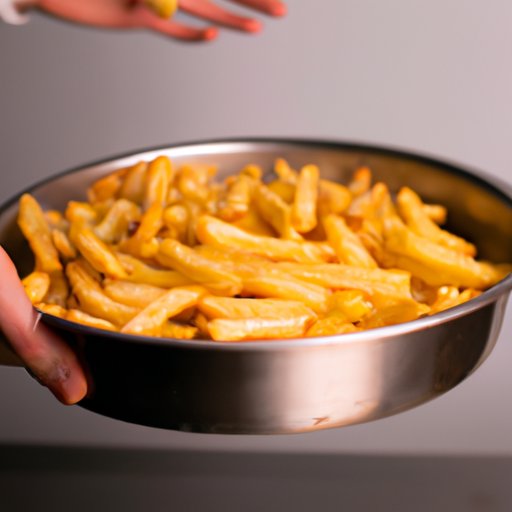I. Introduction
French fries are one of the most beloved fast foods worldwide. They are crispy on the outside and soft, fluffy, and salty on the inside. They are easy to make, and people all the time crave them, but they don’t always want to go to a restaurant to get them. That’s why we created this guide to educate you on how to make homemade French fries.
II. Step-by-Step Guide
The required ingredients are simple: potatoes, vegetable or olive oil, salt, and preferred seasoning, and you’ll need a large pot or deep fryer, slotted spoon, paper towels, and a sharp knife.
To prepare for frying, first, wash the potatoes thoroughly. You can peel or leave the skin on, depending on your preference. Then cut the potatoes into pencil-thin sticks, making sure that they are of even size. To prevent potatoes from sticking together, dry the potato’s surface using paper towels.
Heat oil in a deep fryer or a pot to 325 degrees F and fry potatoes in small batches, making sure not to overcrowd the pot. Fry for 3-4 minutes, remove from the oil with a slotted spoon, and place them onto a paper towel. Raise the temperature of the oil to 375 degrees F and place the potatoes back in batches. Fry until golden brown for around 3-4 minutes per batch. Finally, remove them from the oil and let them drain on paper towels. Season your fries with salt and preferred spices, like garlic, thyme, and oregano.
III. Healthier Variations
French fries can be a healthy option when you make them at home. For a healthy twist on traditional French fries, you can use sweet potatoes, zucchini, or butternut squash instead of potatoes. Baked fries are also healthier than deep-fried ones. Preheat your oven to 400 degrees F, cut the potatoes or vegetables into 1/4 inch-thick sticks, and spread them out on a baking tray. Bake for around 20 to 25 minutes or until they’re crispy and golden brown. Some people prefer to use olive oil because it is much healthier than vegetable oil. Olive oil is rich in healthy fats and antioxidants, making it an overall healthier choice.
IV. Seasonal Twists
Seasonal twists on homemade French fries are a fun way to include the seasonal flavors in your cooking. Thanksgiving and Christmas fries are a fantastic idea for festive occasions. Cut the potatoes into the desired shape and boil them for five minutes. Season the fries with cinnamon, pumpkin spice, and ginger. Fry them the same way as usual and serve them alongside cranberry sauce, a classic Thanksgiving pairing.
V. International Flavors
Around the world, every culture enjoys fries. For a Belgian twist, double-fry the french fries, making them crispy on the outside with a soft inside. Add a dollop of mayonnaise on the side. Indian-style curry fries are a flavorful way to add a curry kick to your fries. Use a high-quality curry powder to season your potatoes post-frying. If you prefer a savory and cheesy flavor, you can’t miss the Canadian-style poutine. Top your French fries with gravy and cheese curds for a delicious treat.
VI. Carrier Alternatives
French fries can be eaten with more than ketchup dip. You can try placing the fries atop loaded burgers for an unforgettable experience. Pita bread with tzatziki sauce is a delicious alternative to french fry carriers. Lettuce cups with French fries for a healthy carb option are another way to include fries in your diet.
VII. Conclusion
Congratulations, you’ve now learned how to make homemade French fries. Remember that frying at home can be a bit tricky, but it is worth the effort. You can always improve your recipe by trying out different variations of potatoes or seasoning them with new spices. Making French fries is an art, and now you are on your way to mastering it.
